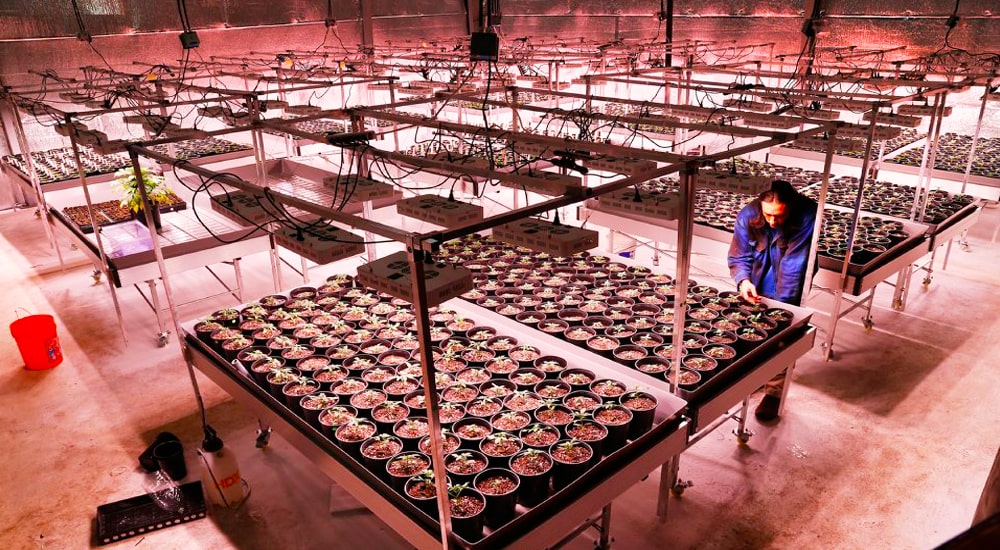
Indoor cultivation has gained significant popularity, whether for commercial farming, home gardening, or hobbyist growing of plants such as vegetables, herbs, or cannabis. One essential component of a successful indoor growing system is the grow rack, which serves as the framework for holding plants and other equipment. While choosing the right size and design is important, selecting the most durable materials for these racks is critical to ensure longevity, cost-effectiveness, and the overall success of the growing process.
The materials used for indoor grow racks directly affect their durability, weight capacity, resistance to environmental factors like humidity, and ease of maintenance. This article will explore the different materials commonly used for constructing indoor grow racks and analyze their durability, suitability for different types of plants, and overall effectiveness. By the end of this guide, you'll be able to make an informed decision about which material is best for your indoor grow system.
Key Factors in Determining Material Durability
Before diving into specific materials, it's essential to understand the factors that determine how durable a material is for indoor grow racks. These factors include:
- Load-Bearing Capacity: The material must be strong enough to hold the weight of plant containers, grow lights, and other equipment.
- Corrosion Resistance: Since indoor growing often involves high humidity and moisture, materials need to resist corrosion and rust.
- Impact Resistance: The racks may need to withstand accidental bumps or drops from equipment or tools.
- Longevity: A durable material should be able to withstand the test of time and offer many years of use without frequent repairs or replacement.
- Ease of Cleaning and Maintenance: The material should be easy to clean and maintain, especially in a controlled environment where hygiene is important.
With these factors in mind, let's take a closer look at the most common materials used for indoor grow racks and assess their durability.
1. Steel
Steel is one of the most popular materials used for indoor grow racks, especially in commercial setups. It is well-known for its strength, making it an excellent choice for supporting heavy loads such as large pots, grow lights, and irrigation systems.
Pros:
- High Load Capacity: Steel can support heavy weights, making it ideal for large-scale operations with multiple layers of plants and equipment.
- Corrosion-Resistant Coatings: Many steel racks are coated with protective layers, such as galvanized steel or powder coating, which prevent rust and corrosion, especially in high-humidity environments.
- Durability: Steel racks have a long lifespan and can withstand impacts, making them a robust and long-term investment.
- Customizability: Steel racks can be easily customized to fit the specific dimensions and layout of an indoor grow space.
Cons:
- Heavy Weight: Steel racks are heavier than those made of other materials, making them less portable. However, this also means they are more stable and secure.
- Higher Cost: Steel grow racks tend to be more expensive upfront compared to alternatives like plastic or wood, but their durability may offset the initial cost.
Best Uses:
Steel grow racks are ideal for commercial indoor farms or large-scale home gardening setups where heavy loads and long-term durability are essential.
2. Aluminum
Aluminum is another excellent option for indoor grow racks due to its lightweight nature, corrosion resistance, and moderate strength. It is particularly popular in smaller-scale setups or where portability is required.
Pros:
- Lightweight: Aluminum is significantly lighter than steel, making it easier to move racks around as needed without sacrificing too much strength.
- Corrosion Resistance: Aluminum naturally resists corrosion, even in environments with high humidity, making it ideal for indoor growing conditions.
- Moderate Strength: While not as strong as steel, aluminum can still hold moderate loads and is suitable for most indoor growing needs.
- Low Maintenance: Aluminum racks require minimal maintenance and are easy to clean, making them a good choice for growers who prefer low-maintenance solutions.
Cons:
- Lower Load Capacity: Compared to steel, aluminum has a lower load-bearing capacity, which may limit the number of layers and the weight of equipment it can support.
- Higher Cost than Plastic: Although aluminum is less expensive than steel, it is more costly than plastic, which might be a consideration for budget-conscious growers.
Best Uses:
Aluminum grow racks are perfect for home gardening or smaller commercial setups where mobility and corrosion resistance are prioritized, but the load requirements are not as demanding.
3. Plastic (PVC)
Plastic, specifically PVC (polyvinyl chloride), is a popular choice for budget-conscious growers or those looking for lightweight, portable options. PVC grow racks can be used for smaller setups or hobbyist indoor gardens.
Pros:
- Affordable: Plastic grow racks are generally the most cost-effective option, making them accessible for beginners or growers on a tight budget.
- Lightweight and Portable: PVC is lightweight and easy to move around, which is beneficial for rearranging a growing space or adjusting the setup as needed.
- Corrosion Resistance: Unlike metal, plastic does not corrode or rust in humid environments, making it a viable option for indoor growing.
- Ease of Assembly: Plastic grow racks are often designed for easy assembly and disassembly, which can be useful for temporary setups or those that need frequent adjustments.
Cons:
- Low Load Capacity: PVC racks are not designed to hold heavy loads, so they may not be suitable for commercial setups or heavy pots and equipment.
- Lower Durability: Plastic is less durable than metal options like steel or aluminum and may crack or warp over time, especially under the stress of heavy weights.
- Limited Lifespan: While affordable, plastic grow racks may need to be replaced more frequently due to wear and tear.
Best Uses:
PVC grow racks are best suited for small-scale indoor gardens, such as those for herbs, seedlings, or lightweight plants. They are ideal for beginner growers or those with limited budgets.
4. Wood
While wood is less commonly used in commercial indoor grow systems, it can still be a viable option for home gardeners or hobbyists. Wood racks offer an aesthetic appeal and are relatively sturdy, but they come with some limitations when used in high-humidity environments.
Pros:
- Natural Look: Wooden grow racks add a natural aesthetic to indoor growing spaces, which some growers prefer for home environments.
- Customizable: Wood is easy to cut, shape, and assemble, making it a flexible material for custom designs and layouts.
- Moderate Strength: Depending on the type of wood used, wooden racks can support moderate loads, making them suitable for smaller indoor gardens.
Cons:
- Vulnerability to Moisture: Wood is susceptible to rotting, mold, and warping in high-humidity environments unless treated with protective coatings. This makes it less durable in indoor grow rooms where moisture levels are high.
- High Maintenance: Wooden racks require more maintenance, including regular sealing or varnishing to prevent moisture damage.
- Weight: Depending on the type of wood, these racks can be heavy, making them less portable than plastic but not as heavy-duty as steel.
Best Uses:
Wooden grow racks work best in dry indoor environments where aesthetics are a priority. They are suitable for small home gardens with moderate load requirements but are not ideal for high-humidity or commercial environments.
5. Wire Shelving
Wire shelving is a hybrid material often made from steel with a coating of plastic or another anti-corrosive material. It is lightweight, relatively strong, and provides good ventilation for plants, making it a versatile choice for indoor grow systems.
Pros:
- Good Ventilation: The open design of wire shelving allows for excellent airflow and drainage, which is beneficial for plant growth.
- Corrosion-Resistant Coating: Wire shelving is usually coated with plastic or another material to prevent rust and corrosion, making it durable in humid environments.
- Lightweight: Wire shelving is lighter than solid metal racks but still strong enough to hold moderate loads.
- Affordable: Wire shelving is generally more affordable than solid metal racks, making it a cost-effective option for many growers.
Cons:
- Limited Load Capacity: Although wire shelving is stronger than plastic, it cannot support as much weight as solid steel or aluminum.
- Flexibility: Some wire shelves may bend or flex under heavy loads, so it’s important to distribute weight evenly.
Best Uses:
Wire shelving is ideal for medium-sized indoor gardens or grow rooms where ventilation and airflow are important. It is suitable for growers who need a balance between cost, durability, and load capacity.
6. Composite Materials
Composite materials, made from a combination of wood fibers, plastic, and other materials, are becoming more popular in indoor growing environments. These materials offer the durability of metal with the aesthetic appeal of wood.
Pros:
- Durability: Composite materials are designed to withstand humidity and moisture without warping or rotting, making them highly durable in indoor environments.
- Customizable: Like wood, composite materials can be shaped and assembled into various designs, providing flexibility in setup.
- Corrosion Resistance: Many composite materials are resistant to rust and corrosion, similar to plastic and aluminum.
Cons:
- Cost: Composite materials tend to be more expensive than plastic and sometimes even aluminum, though they offer longer lifespans and better durability.
- Weight: Depending on the composition, some composite materials can be heavy, making them less portable.
Best Uses:
Composite materials are best for growers who want the aesthetic of wood but need the durability of metal. They are suited for medium to large indoor growing systems where moisture resistance and longevity are crucial.
Conclusion
Selecting the most durable material for indoor grow racks depends on several factors, including the size of the growing operation, the weight of the plants and equipment, and the environmental conditions of the grow space. Steel remains the most durable option for heavy-duty commercial setups, offering high load-bearing capacity and long-term durability. Aluminum provides a lighter, corrosion-resistant alternative for smaller or more mobile systems. For budget-conscious growers or beginners, PVC or wire shelving can offer affordable and easy-to-maintain options. Finally, for those who prefer a natural aesthetic, wood or composite materials can be considered, though they may require additional maintenance in humid environments.
Ultimately, the best material for your grow racks will depend on the specific needs of your indoor growing system, including the types of plants you are cultivating, the size of your setup, and your budget. By carefully considering the pros and cons of each material, you can choose a grow rack that will stand the test of time and help you create a thriving indoor garden.





